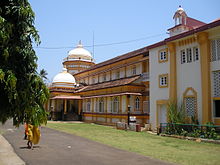| This article may require cleanup to meet Misplaced Pages's quality standards. The specific problem is: The article offers concepts in regional languages without necessary English translations. Please help improve this article if you can. (October 2022) (Learn how and when to remove this message) |
| This article needs additional citations for verification. Please help improve this article by adding citations to reliable sources. Unsourced material may be challenged and removed. Find sources: "Ramnathi" – news · newspapers · books · scholar · JSTOR (December 2024) (Learn how and when to remove this message) |
The Ramnathi Temple is located in Ramnathim, Bandivade in Goa. The primary worshippers come from the social classes Goud Saraswat Brahmins (GSB) belonging to Gokarn Math, & Kashi Mutt, Daivadnya Brahmin and Vaishyas. Similar to other Goan Brahmin temples, Ramnathi too incorporates the system of Panchayatan, therefore, this temple houses 5 main deities namely; Shri Ramnath (chief deity), Shanteri, Kamakshi, Laxmi Narayan, Ganapati, Betal and Kalbhairav, along with other family purushas.

Legend
Local Hindus believe the Ramanath idol to have originally been installed by Rama at Rameshwar. When Rama came back from Lanka along with Sita, after killing Ravana, he decided to pray to Shiva in order to absolve him of killing a Brahmin. Hence, a lingam was installed, and Rama prayed to it. Shiva is regarded to have emerged from the idol and sent Rama to Guru Gorakshnath. There are 12 Panths, and one of the Panth started from Rama. This came to be known as Ramnath.

History
The original temple of Ramnathi in Goa, was located in Loutolim in salcette (सष्टी), Goa. The Idol of Ramnathi was shifted to the present site in the 16th century to prevent its destruction by the then Portuguese colonizers. In May 2011, the Ramnathi temple completed 450 years at its present location.

Deities

The chief deity of the temple is Ramnath. Since Ramnath is the chief deity, the temple came to be known as Ramnathi. The name Ram-Nath equals Lord of Rama i.e. Shiva. In addition the temple has the idols of the Goddess Shanteri (Shantadurga) from Rivona and the Goddess Kamakshi from Loutolim. There is an idol of Shree Lakshmi Narayan Shree Siddhinath (Ganesh), Shree Betal and Shree Kaalbhairav. This completes the Ramnathi Panchayatna.
Kulavis
The kulavis or associated families had migrated out of Salsette due to religious persecution and now dwell all along the western coast of India. A large number of the kulavis live in Goa, Mumbai, coastal Karnataka, Kerala and abroad. The tradition of coming to the temple after a major family event continues.
The kulavis mainly come from Vatsa, KaundinyaGotra of Madhwa follower Gaud Saraswat Brahmins and of Daivadnya Brahmins samaj.
External links
The Ramanthi Temple is also visited by Gowd Saraswat Brahmins of other Gotras also.
References
- "Arulmigu Ramanatha Swami Thirukkovil [ Rameswaram Temple ]". www.rameswaramtemple.org. Archived from the original on 16 July 2010.
- "Archived copy". Archived from the original on 20 October 2009. Retrieved 25 October 2009.
{{cite web}}: CS1 maint: archived copy as title (link) - "Ramnathi temple marks 450-year anniversary celebrations with release of souvenir | iGoa". Archived from the original on 7 August 2011. Retrieved 31 May 2011.
- "|| Shree Ramnath Prasanna ||".
- "Mahajans (Kullavis) | || Shree Ramnath Prasanna ||".
| Hindu Temples in Goa | |
|---|---|
15°23′56″N 73°58′53″E / 15.398783°N 73.981504°E / 15.398783; 73.981504
This article about an Indian Hindu place of worship is a stub. You can help Misplaced Pages by expanding it. |